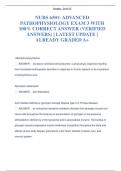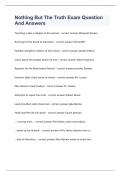Deeagles - Stuvia US
NURS 6501- ADVANCED
PATHOPHYSIOLOGY EXAM 3 WITH
100% CORRECT ANSWER (VERIFIED
ANSWERS) | LATEST UPDATE |
ALREADY GRADED A+
Absolute polycythemia
ANSWER: excessive red blood cell production; a physiologic response resulting
from increased erythropoietin secretion in response to chronic hypoxia or as a symptom
of polycythemia vera.
Absorption atelectasis
ANSWER: see Atelectasis.
Acid maltase deficiency (glycogen storage disease type II or Pompe disease)
ANSWER: an autosomal recessive metabolic disorder that damages muscle and
nerve cells throughout the body by an accumulation of glycogen in the lysosome
attributable to deficiency of the lysosomal acid a-glucosidase enzyme. The buildup of
glycogen causes progressive muscle weakness (myopathy) throughout the body and
affects various body tissues, particularly in the heart, skeletal muscles, liver, and
nervous system.
, Deeagles - Stuvia US
Acne
ANSWER: a common skin disease characterized by pimples on the face, chest,
and back. It occurs when the pores of the skin become clogged with oil, dead skin cells,
and bacteria.
Acne conglobata
ANSWER: severe cystic acne characterized by cystic lesions, abscesses,
communicating sinuses, and thickened, nodular scars; usually does not affect the face.
Acne rosacea
ANSWER: a chronic form of dermatitis of the face in which the middle portion of
the face appears red with small red lines caused by dilation of capillaries.
Acne vulgaris
ANSWER: an inflammatory eruption of the sebaceous follicles usually occurring
on the face, upper back, and chest that consists of blackheads, cysts, papules, and
pustules.
Noninflammatory acne
ANSWER: open comedones caused by the enlargement and dilation of a plug
resulting from the accumulation of oil and dead skin cells inside the hair follicle and by
closed comedones that form if the hair follicle pore remains closed; they appear as a
tiny, sometimes pink bump in the skin.
, Deeagles - Stuvia US
Acquired immunodeficiency syndrome (AIDS)
ANSWER: see Immune deficiency.
Acquired sideroblastic anemia
ANSWER: see Anemia.
ACTH deficiency
ANSWER: a condition characterized by decreased or absent production of
adrenocorticotropic hormone (ACTH) by the pituitary gland, resulting in a reduction in
the secretion of adrenal hormones and subsequent weight loss, lack of appetite,
weakness, nausea, vomiting, and low blood pressure.
Actinic keratosis
ANSWER: a condition in which a premalignant small, reddish, rough spot appears
on skin chronically exposed to the sun.
Acute chest syndrome
ANSWER: a syndrome occurring in association with sickle cell disease defined by
a new infiltrate on chest radiograph; associated with one or more new symptoms: fever,
cough, sputum production, dyspnea, or hypoxia. It occurs most commonly in the 2- to 4-
year-old age group and declines in incidence with age.
, Deeagles - Stuvia US
Acute colonic pseudo-obstruction (Ogilvie syndrome)
ANSWER: a massive dilation of the large bowel that occurs in critically ill patients
and immobilized older adults. It is characterized by significant dilation of the cecum and
absence of mechanical obstruction, and is related to excessive sympathetic motor input
or decreased parasympathetic motor input.
Acute confusional state (ACS)
ANSWER: a form of delirium caused by interference with the metabolic or other
biochemical processes essential for normal brain functioning. Symptoms may include
disturbances in cognition and levels of awareness, short-term memory deficit,
retrograde and anterograde amnesia, and disturbances in orientation, accompanied by
restlessness, apprehension, irritability, and apathy. The condition may be associated
with an acute physiologic state, delirium, toxic psychosis, or acute brain syndrome.
Acute coronary syndrome
ANSWER: a classification encompassing clinical presentations ranging from
unstable angina through infarction.
Acute cystitis
ANSWER: an inflammation of the bladder, which is the most common site of
urinary tract infection.
Acute epiglottitis






